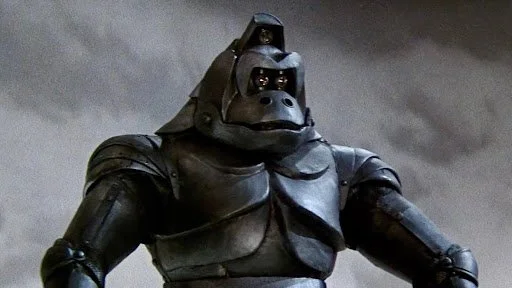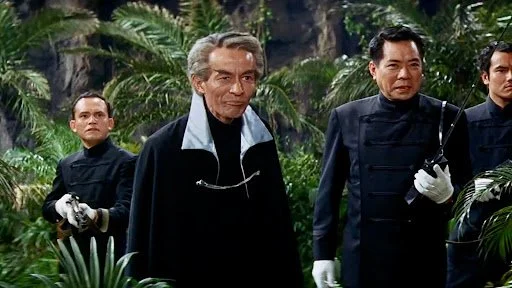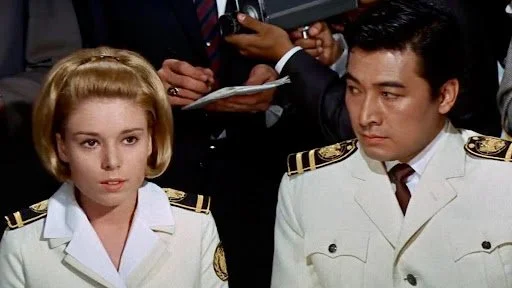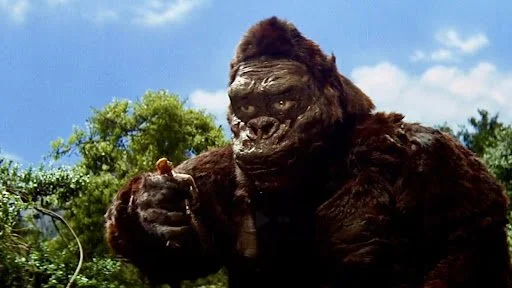Weird Wednesdays: King Kong Escapes
This screening was part of the Alamo Drafthouse’s Weird Wednesday series. For upcoming shows, click here.
Yes, I watch giant ape movies. I watch everything in the kaiju canon. Kaiju movies, for the uninitiated, is a subset of tokusatsu (superhero) movies that originated in Japan. They usually involve a performer wearing a giant monster suit and/or fighting a giant monster. Since it’s origins in the 1950s, the canon has grown beyond Godzilla and Gamera. Like the namesake monsters, the kaiju genre has bounded outside its original borders, crushing model buildings in every country with film-making infrastructure.
The giant ape movie is a sub-genre of the kaiju canon that has its own specific flavor. Dinosaur movies dabble in the fantastic yet somewhat grounded notion, "What if people and dinos could meet face to face?" Traditional Japanese kaiju movies are typically concerned with mankind's flirtation with dangerous technology and our impact on the environment. A giant ape movie may only task the viewer with: "What if there was a gorilla that was just really, really big?" This singular clarity of thought originated at RKO Pictures, in Hollywood California, USA.
So what happens when the Kong franchise bounds outside its California home and we let the Godzilla folks take the reins for a bit? The result is the recent Weird Wednesday showing of King Kong Escapes.
The road to how we got here is a long and winding wikipedia article. The abbreviated version: 1933's King Kong predates all other films in the kaiju canon. The stop-motion masterpiece was very successful but the movie's original distributor, RKO, went out of business anyway. So the rights to the character kind of floated around to the highest bidder from decade to decade. This included a 1966 cartoon series produced by Rankin-Bass Productions (the Rudolph the Red Nosed Reindeer folks), which was animated by the storied Japanese animation house Toei (the One Piece folks.)
Toho Co. (the Godzilla folks) then acquired the film rights to the character. This is how Kong entered the kaiju canon retroactively. They utilized the license to maximum effect, producing one of classic cinema's best giant buddy pictures, King Kong vs. Godzilla. Rankin-Bass re-entered the picture looking for an original Kong feature film to promote their cartoon. Thus a partnership was forged.
The original King Kong was lovingly animated by the legendary Willis H. O'Brien. King Kong Escapes, as a Japanese-American co-production, wears its tokusatsu bonafides on its sleeve. Guys in suits stomping on buildings and model trains. Classic kaiju stuff.
The story is a hodgepodge of elements from things that were floating around in the zeitgeist of the mid-1960s: monsters, mad scientists, nuclear proliferation, and mini-skirts. The evil Dr. Who (not to be confused with the British science fiction hero) just happens to have an arctic hideout where he is mining for a science fictional ore: element X. He has an army of goons but to his credit, his radioactive mine is not full of slaves. But don't start toasting Who for doing the absolute least just yet. He just understands most living things would die before hauling the stuff to the surface.
Here's where his logic gets muddy: Who hasn't invested in drilling machines, radon detectors, or any of the actual equipment to do proper mining. Instead, he committed to the construction of a highly impractical robot duplicate of King Kong before the start of the film. Truly a mad scientist of the highest order.
Wouldn't you know it? The radiation degrades the mecha's brain circuits before it can get any digging done. For the first time in any fiction I can remember, the mechanical duplicate proves inferior to the real thing right off the bat. The solution is clear: Who must capture and brainwash the real King Kong. Surely that can't be that difficult, right?
This leads me to our human protagonists: the crew of a United Nations adjacent super-submarine. The sub is captained by Carl Nelson played by Rhodes Reason and his first officer Jiro Namura played by Akira Takarada. They patrol the South Pacific, ably assisted by super-cute medical officer Susan Watson played by model Linda Jo Miller.
To be clear: I do not intend to minimize Linda or her character by calling her 'cute.' From her pert bob haircut to the squeaky voice they use to dub her dialog, this character is purpose-built to be as cute as possible. Truly the Kristin Chenoweth of her day. As if she was an elf that escaped the set of the Frosty the Snowman TV special. Rest assured it's all for plot reasons.
What follows is a pretty simple story of a submarine captain on a sort of a 'sea quest' if you will. The mission does not necessarily require them to protect or destroy Kong. This detached duty provides an easy excuse to hang out with Kong. Perhaps even help him escape, should Dr. Who, for example, try to harness Kong's power as a one-ape press gang working in his element X mine.
But element X proves to be trickier to work with than uranium. Dr. Who hypnotizes Kong, fitting him with an earpiece like he's doing a Letterman man-on-the-street bit. Instead of sending Kong around the corner to prank a bodega owner, Who sends him down to the mines. Bummer.
Wouldn't you know it? Kong's earpiece also breaks down immediately. Fortunately for Dr. Who, Kong's romantic crush on Susan is public knowledge. In a final bid to control him, Dr. Who kidnaps Susan, knowing the cute diminutive blonde will be irresistible to Kong. My man has a type!
Soon the cavalry arrives, it turns out that Nelson and Who are old nemeses. Which is something that would have been helpful to know in the first act. Although I get the feeling that Dr. Who has a regular rotation of b-grade super-spies trying to foil him: Derek Flint, Craig Gamble, Bart Fargo. Perhaps it’s time for him to find the right arch-nemesis to settle down with for a mature protagonist/antagonist relationship.
For now, Nelson, Jiro, Susan, and Kong are all captured. When all seems lost they stage a daring escape in bargain-basement James Bond-ian fashion. The final showdown between Kong and Mecha-Kong reaches its climax atop Tokyo Tower (natch). There's a very satisfying denouement where Kong attacks and destroys Dr. Who's cargo ship as it (very, very slowly) tries to get away.
Veteran Toho director Ishiro Honda has a firm grasp of Kong as a character. He provides some set pieces that showcase those strengths. Kong fights a dinosaur, climbs a tower or two, and carries Susan around in his giant prop hand for a while (or Susan conveniently turns into a little blonde doll for wide shots). The transition to high definition video was not kind to this movie, but it does make the janky effects considerably more fun.
As a product of its time, King Kong Escapes is not without some regressive issues. Dr. Who is a stereotype, essentially Fu Manchu by another name. At another point, a white character calls an asian character 'Mata Hari.' While there are positive portrayals of Asian characters to provide some counterweight, these troubling artifacts did not escape my notice.
I feel if you can find it within yourself to look past the flaws, the remainder is full of fun sci-fi pulp for the discerning kaiju connoisseur. Honda demonstrates an awareness that his audience is broader than Japan or America. The result is a globe-trotting story with a multi-national cast that provides the movie the largest possible sandbox to play in. While he was born in the USA, King Kong belongs to the world.
If you enjoyed this article, please consider becoming a patron of Hyperreal Film Journal for as low as $3 a month!








Collin Cannaday is an Austin author, screenwriter, essayist, humorist, satirist and dramatist. He currently co-hosts the Are You Karate Kidding Me?! podcast recapping the Karate Kid movies and Cobra Kai. Subscribe on your podcatcher of choice. Follow him on Letterboxd: @ccann or on Bluesky: @collincannaday.com